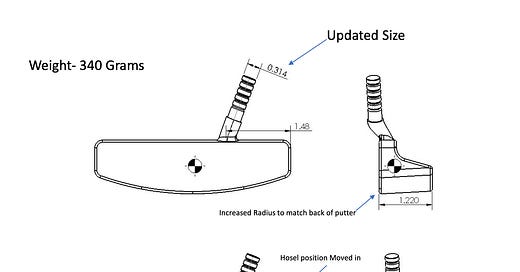Last week we started a discussion on how styles of putting strokes might differ, yet still be effective. The concept being your way, is better than an advertised best way. We talked about a stroke that flows from the shoulders, arms, and wrists, with many moving parts and compared the rhythm of that to one that is more chest and shoulder driven. That comparison is just one of many comparisons we use to evaluate your stroke and along with that, what putter design might suit you best. How would you decide what style of motion best suits you? Our evaluation begins with a question.
Are you Face Aware during the stroke or are you Path Aware?
We have several tools to help us decide, but the easiest and the one that is most informative is to judge how you react to a missed putt? I use a flat putt of 10 to 15 feet. Ask the player to start hitting putts from the same spot. Eventually there is a missed putt. If they don’t miss, they don’t need the evaluation in the first place. We watch very carefully how they react. The path aware player will adjust the direction of the path, taking the putter more outside on the backswing if the miss was a push and more inside on the backswing if the miss was a pull. This often comes with a change in body alignment as well. Path Aware players often use chest and shoulder driven strokes, with passive hands.
The Face Aware player will adjust the position and use of the hands. They judge by how they finish the stroke. Face aware players will often judge the position of the putter face by judging the location of the toe of the putter. A Face Aware player will often adjust how they use their hands. Releasing the toe of the putter through the ball or holding off depending on the miss. They are very sensitive to grip pressure and grip style. Path Aware players being just the opposite. They will often choose a grip style that “eliminates” the hands in the stroke. Grip to style is a subject for another conversation.
If you think of the stroke in this way, it might make more sense to the choice of a putter with some toe flow, or one built to minimize the feel of torque in the stroke, with a toe up balance or one that balances with the face parallel to the ground. We feel so strongly about this that we used this consideration as a fitting tool in our putters. We have the Face Aware model in 3 weights and the Path Aware model in the same 3 weights. We did it with hosel location and it has proved to be very effective in helping a player find the correct model. In the diagram below is the 340 gram model. The hosel 1.48 from the heel of the putter is for the Face aware player. The bottom putter at 1.8 for Path Aware player.
s
Coming next is a more detailed description of Path Aware tendencies. That to be followed by Face Aware tendencies. With each of these articles there will be a brief podcast to supplement each article. For the future that will be the goal. A written document to introduce the subject, coupled with a podcast of my opinions on the subject and how we use the concepts in our fitting and instruction. The intent is to position the podcast behind a paywall. The articles like this one will remain free to the subscribers.
Follow this link to learn more about what is in store..




